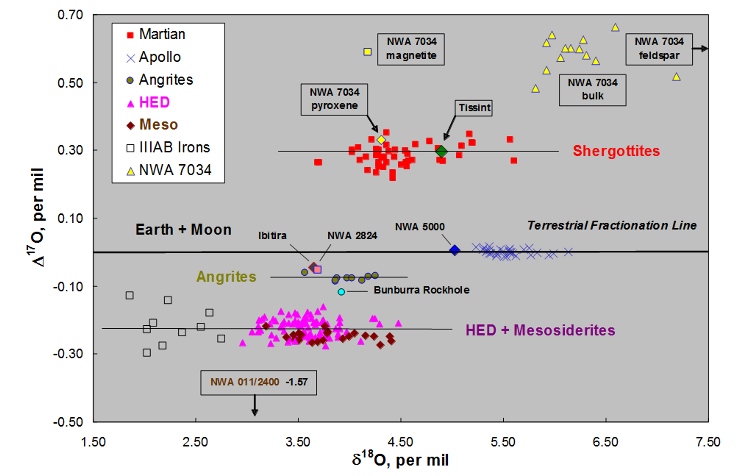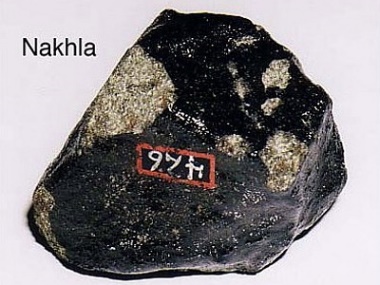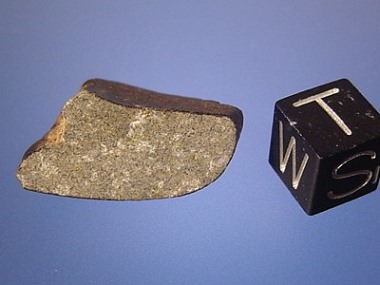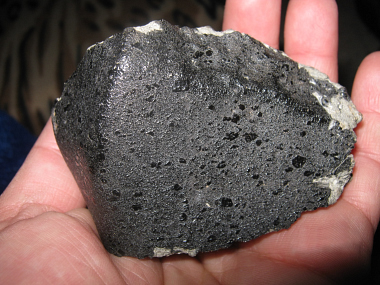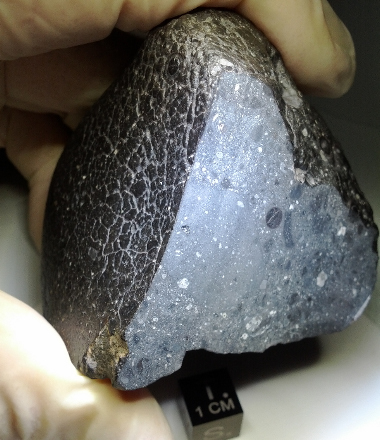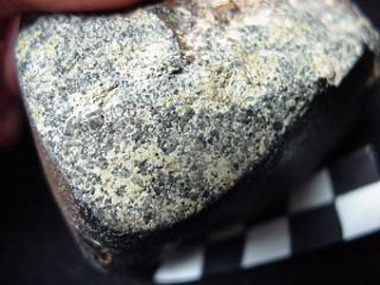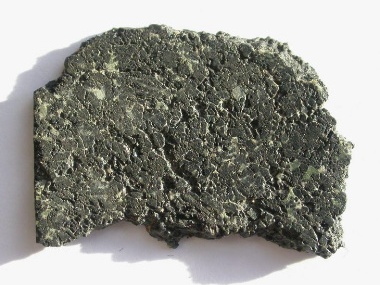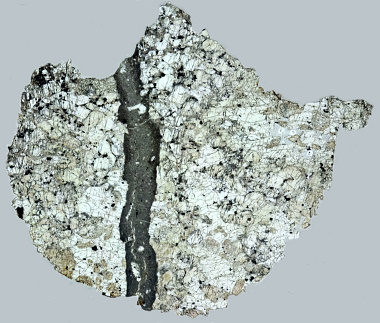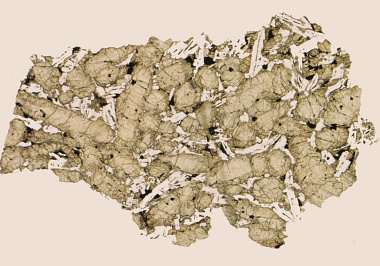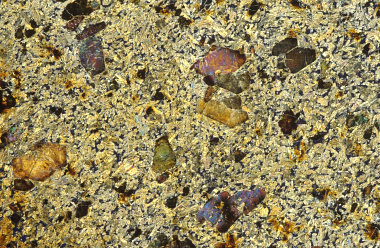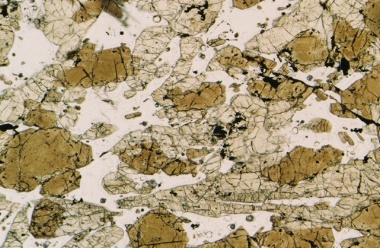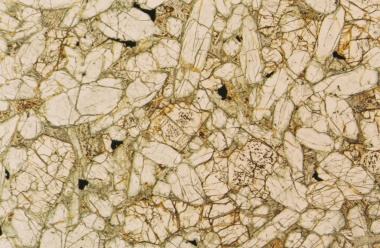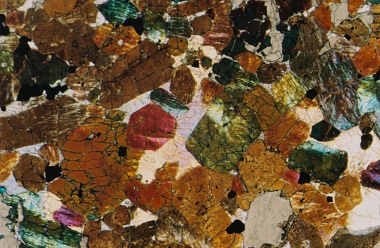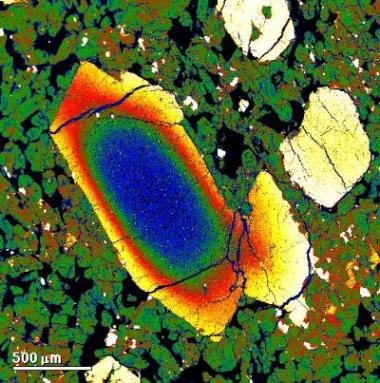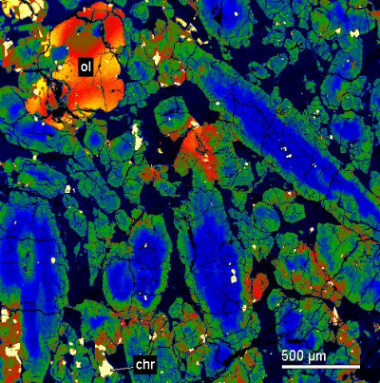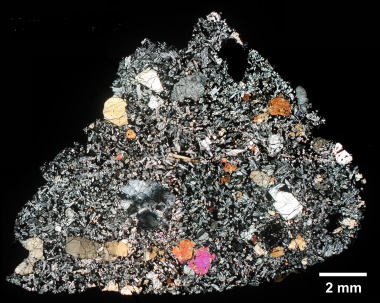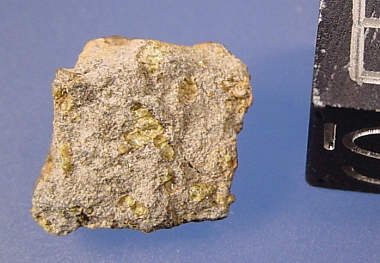Martian Meteorites
For a current list of
classified specimens, click
here
This site has been developed to fill a perceived need for an up-to-date source of accessible information specifically on Martian meteorites for educators, researchers and collectors. It is intended to be complementary to several other excellent websites, such as the NASA Mars Meteorite Compendium, which is a comprehensive summary of research information on Martian meteorites. A useful summary of all types of meteorites (including Martian examples) can be found on the Northern Arizona University website. One colleague who deserves special mention is Dr. Ted Bunch, who not only has been a valued collaborator in our joint research on Martian meteorites, but who generously provided many of the thin section photomicrographs on the linked individual pages for Martian specimens (to be added soon).
What are meteorites?
Meteorites are objects
composed of rock and sometimes metal which are derived from various
solar system bodies, and after traveling through space land on the
surfaces of other solar system bodies (notably Earth, but also the Moon
and Mars, and no doubt other worlds). Most meteorites are not observed
to fall, but instead are found long afterwards, and then must be
subjected to a variety of forensic tests to ascertain their provenance.
It's truly a scientific detective story!
Most meteorites are reasonably inferred to come from relatively small
bodies (up to several hundred kilometers in diameter, but mostly much
smaller) located within the Main Asteroid Belt, which is a collection of
more than 100,000 objects larger than 1 km constrained by celestial
mechanics to orbit the Sun between Mars and Jupiter. (Contrary to scenes
from the movie Star Wars, there now are very large distances between
each of the asteroids, but they do get hit by other orbiting objects, or
are gradually moved into transfer orbits from which they can be
perturbed into Earth-crossing trajectories). This diverse collection of
asteroids may include primitive objects (that is, early, unprocessed
material left over from the accretion or partial accretion of the
planets from the solar nebula), but also the disaggregated remains of
now destroyed former planetary bodies, some of which had resided much
closer to the Sun. There are other known asteroids that do not orbit
within the Main Belt (such as various near Earth objects or NEOs), and
some of these also could be sources of meteorites.
The most prevalent meteorites found on Earth contain small, partly
glassy spheres called chondrules, and such rocks are termed chondrites
(of at least 14 different types). Other meteorites lacking chondrules
are called achondrites, and a subset of those are commonly referred to
as planetary meteorites. This latter group comprises meteorites that
derive from current or former bodies of sufficient size and with enough
heat that they became internally layered (or differentiated), with a
dense core and an overlying lithosphere (composed of a mantle and
sometimes a crust as well). The relatively rare iron meteorites and also
the pallasites presumably represent the disaggregated cores of former
planetary bodies.
How did Martian meteorites get here?
Gravitational interactions among all bodies orbiting the Sun cause perturbations that result in collisions between some of them. Early in solar system history such collisions almost certainly were much more frequent and involved much larger masses, so it is not difficult to imagine that some fairly large bodies were destroyed and dispersed in such events. Today, the interactions that ultimately deliver meteorites to us are less energetic, yet still can cause small pieces of a large body struck by a smaller object to be ejected at a rate that exceeds the escape velocity needed to overcome the gravitational force of the larger body. For Mars (with a gravitational acceleration about 0.38 that of Earth) this requires a fairly energetic collision by a small asteroid onto the Martian surface. The material so excavated could consist of rocks outcropping at the surface and/or subsurface samples from a certain depth. In the early 1980s scientists were skeptical that specimens that we now know to come from Mars actually could be accelerated enough to escape Mars gravity. Once the Martian origin of some specimens became undeniable (see below), theorists were forced to reconsider the physics of this process, and discovered that it was indeed possible to eject material by a mechanism called spallation. The fact that all Martian meteorites show evidence of moderate to high shock pressures is very consistent with these conclusions.
How do we know they are pieces from Mars?
The detective work that eventually connected a small group of strange achondritic meteorites to a fairly well known planet is a remarkable philosophical achievement. Actually, solving this case depended on a relatively unheralded measurement by the two NASA Viking spacecraft that landed on Mars in 1976. Although sent to conduct experiments to detect extant life in Martian soil (which they did not), the Viking landers gained redemption of sorts because the instruments measured the amounts of different gases in the thin Martian atmosphere. Those same gases were first found in 1983 by Donald Bogard and Pratt Johnson in very small amounts (but in the exact same proportions) trapped within shock glass veins and pockets in shergottite Elephant Moraine 79001, and now in at least five other Martian meteorites (see plot).
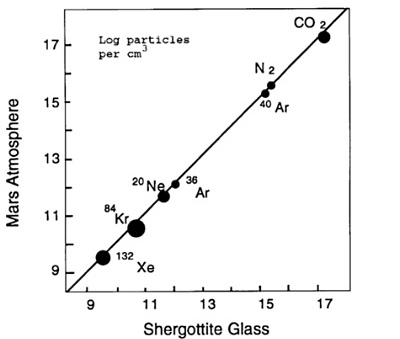
So what about all of the other alleged Martian meteorites? It turns out that all of them have kinship based on several other diagnostic criteria: (1) they all contain iron-rich oxide minerals (magnetite, chromite, ilmenite) and no iron in metallic form, (2) they all contain an iron sulfide mineral called pyrrhotite, instead of troilite (as found typically in iron metal-bearing meteorites), (3) the pyroxene and olivine minerals within them have ratios of Fe (iron) to Mn (manganese) that are distinctive (see plot below), and mostly significantly, (4) they have a narrow range of oxygen isotopic compositions different from those of any other achondritic meteorites (see plot below). Taken together, these forensic measures constitute a preponderance of evidence that all the 207 or so proposed Martian meteorites are from the same body, and the atmospheric gas evidence proves beyond doubt that the body is in fact Mars. Thus, unlike the case for lunar meteorites, we have the curious circumstance of knowing that these specimens come from Mars even though humans have not yet obtained directly any rock samples from there. Even more intriguing is the fact that none of the Martian meteorites (possibly with one exception) seem to be very similar to the rock outcrops at any landing sites explored so far with robotic craft. However, the bulk FeO/MnO ratios for the freshest rocks at Gusev crater are very similar to the bulk FeO/MnO ratios for shergottites, providing another very strong link.
Mineral chemical
discrimination of planetary basaltic rocks. Magmatic rocks on different
planetary bodies have different ratios of Fe/Mn in their mafic silicates
and/or different
Ca/Na ratios in their constituent plagioclase feldspars
Oxygen isotopic
compositions of planetary achondrites
(all data by laser fusion, except for IIIAB irons)
What's in a name?
In the late 1970s
scientists came to realize that three odd groups of achondrites known at
that time (three shergottites, three nakhlites and a unique stone called
Chassigny) might be genetically related, and a few scientists (notably
Lewis Ashwal and Edward Stolper) even dared to hypothesize that all of
these may come from Mars. One line of argument was that since these were
all igneous rocks containing oxide minerals with iron partly in the
ferric form, they must come from a fairly large body capable of internal
melting, and furthermore one which is relatively oxidized. The 1976 NASA Viking
landers supported the conjecture that the distinctive overall reddish
color of Mars was caused by surface dust deposits that strongly
resembled mixtures of clay and ferric oxides, like those produced by
weathering of terrestrial lavas. In addition, radiometric dating of
several shergottites by Laurence Nyquist and colleagues demonstrated in
1979 that at least part of their parent body had experienced magmatism
within the last several hundred million years.
As a convenient acronym, these specimens were dubbed the SNC meteorites,
but worse was the colloquial use of the term SNCs (commonly pronounced
in oral presentations as Snicks). Some scientists still use this term,
but most have abandoned it in favor of the much more direct and simpler
term Martian meteorites. The discovery of the Antarctic meteorite
Allan Hills 84001, which is a unique Martian orthopyroxenite (rather
than an S, N or C variety), influenced this change in terminology.
How many are there?
Until 1977 there were only six known specimens that were to become recognized as Martian meteorites. Today the number of separate Martian meteorites is about 207, although for some of these there is more than one officially recognized name, because of naturally paired stones or broken pieces of the same original single stone. One remarkable Martian meteorite (Elephant Moraine 79001) has two different lithologies in contact, but is still counted as one specimen here. The actual number of unpaired Martian meteorites is probably slightly less than 207, because it is difficult to decide about pairing relationships among some stones without sophisticated analyses (such as determinations of cosmic ray exposure ages). The specimens which are listed together in single entries on the linked List are judged by the author to be paired based on the best available information, but some of those assignments may be subject to change as additional data are obtained.
How big are they?
The largest Martian meteorite is Zagami at 18.0 kg (40 lbs), followed by Yamato 000593 and paired stones at 15.0 kg (33 lbs), Tissint at >12 kg (>26 lbs), Sayh al Uhaymir 005 and paired stones at 11.2 kg (25 lbs), Dar al Gani 476 and paired stones at 10.4 kg (23 lbs), and the numerous stones of Nakhla at 9.9 kg (22 lbs). The smallest unpaired Martian meteorites are Grove Mountains 020090 (7.5 grams), Grove Mountains 99027 (10 grams), Queen Alexandria Range 94201 (12 grams), Northwest Africa 4480 (13 grams) and Lewis Cliff 88516 (13.2 grams).
|
|
|
|
A small
Nakhla individual stone |
Northwest
Africa 4480. Cube is 1 cm |
Where are they found? And by whom?
Annual expeditions to Antarctica since 1975 by Japanese, USA, and more recently Chinese government-sponsored teams have resulted in a steady increase in the number of Martian specimens. The first Antarctic Martian meteorite (Allan Hills 77005) was found on December 29, 1977, the second one in 1979, and the most recent one (Larkman Nunatak 12095/12240) in January 2012. Additionally, in the late 1990s exploration of the rocky deserts of Northwest Africa and Oman (supported largely by private collectors) led to a dramatic increase in recovered specimens that still has not abated. In fact, over half (62%) of all Martian meteorites found since 1975 are from Algeria, Morocco and adjacent regions; one is from Libya and four are from Oman. Video documentation about the discovery of the Ksar Ghilane 002 Martian meteorite in Tunisia is at (weblink). Although most meteorites must fall in the ocean, there can be no doubt that Martian meteorites have fallen on land everywhere, if only we could recognize them in forested or urban areas. There are other rocky deserts (for example, in Australia, Mongolia and the western USA) that would be fruitful places to search. Given the success of nomads in Northwest Africa and others in Oman, it must be concluded that future discoveries elsewhere are limited mainly by insufficient effort. Let's get going!
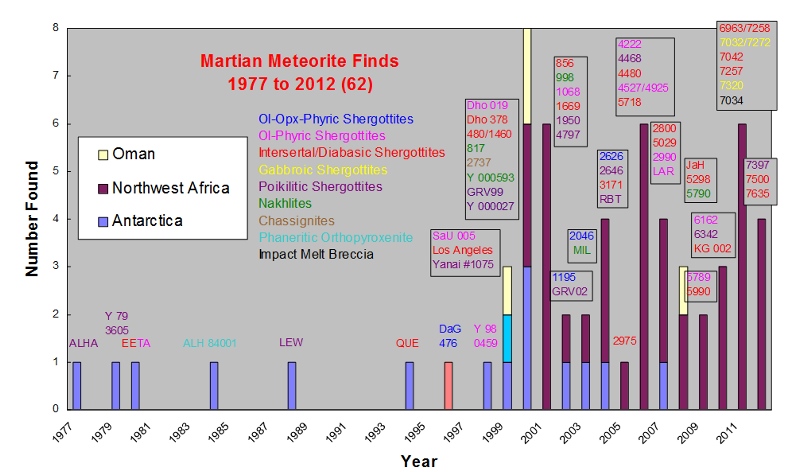
Statistics of unpaired Martian meteorite finds (numbers are NWA names; Unn = unnamed)
Four famous falls
The number of lunar meteorites (presently about 196 - see here) is similar to the number of Martian meteorites, yet not a single lunar meteorite has been witnessed to fall. In contrast, four Martian meteorites (Chassigny, Shergotty, Nakhla and Zagami) were observed striking this planet, and it is remarkable that these represent three of the major subgroups (Shergotty and Zagami are very similar to each other). The stories of the falls of these special meteorites in 1815, 1865, 1911 and 1962 are well documented elsewhere.
The Tissint, Morocco shergottite fall in 2011
The fifth witnessed fall of a Martian meteorite occurred in the early hours of July 18, 2011 in a remote rocky desert region southwest of Tissint, Morocco. The meteorite pieces (in total over 12 kilograms) were not found until about 4 months later, but the freshness of both the fusion crust and the interior of numerous broken fragments are quite consistent with the earlier visual and auditory accounts by local observers. The amounts of the short-lived cosmogenic nuclides 54Mn and 22Na detected in a specimen analyzed by Dr. John Duke at the University of Alberta are consistent with a very recent fall date (at least within the last 5 years). The meteorite was named Tissint (pronounced Tee.seent) after the village located about 70 km from the strewnfield. In Berber this name means salt, in reference to the saline water and salt deposits in this region on the north side of the Oued Drâa intermittent watershed, which separates Morocco from Algeria.
|
|
|
|
297g
broken stone of Tissint |
The same 297g stone (back) |
Tissint is
a different variety of shergottite from the two previous shergottite
falls (Shergotty and Zagami), but similar to a group of 11 other
shergottites (termed olivine-phyric) found elsewhere in northern Africa,
Oman and Antarctica. The large olivine grains exposed on the exterior of
the Tissint meteoroid melted in a distinctive way as it plunged through our atmosphere, as is
evident in the picture above. The obverse side of the same piece reveals
the pale gray interior with its sporadic pockets of vesicular black
glass (formed by shock as the material was ejected from Mars). If
Tissint is indeed like the other compositionally-similar olivine-phyric
shergottites, then it might be expected to have an igneous formation age
near 460 million years ago and may have been ejected (along with the
other 11 similar examples) about 1.1 million years ago.
*Ejection Age:
Drs. Marc Caffee and Kunihiko Nishiizumi have determined the ejection
age for two samples of Tissint from measurements of cosmogenic
beryllium-10 to be 1.1 Ma. This result fully supports their hypothesis
that ALL of the depleted olivine-phyric shergottites (with the notable
exception of Dhofar 019) were ejected from Mars together at this time,
but landed on Earth at various times over the past 450,000 years (and as
remarkable as it seems predominantly in Northwest African countries).
Dhofar 019 has the longest space age measured so far for any Martian
meteorite (20 million years).
*Crystallization
Age: Analyses
to determine the crystallization age for Tissint using Sr, Nd and Hf
isotopes have been undertaken in several laboratories. Dr. Gregory
Brennecka, Dr. Lars Borg and Dr. Meenakshi Wadhwa determined a
preliminary Sm-Nd isochron age of 596 ± 23 million years. Therica
Grosshans, Dr. Thomas Lapen and Dr. Rasmus Andreasen obtained a Sm-Nd
mineral isochron age of 616 ± 67 million years and a less precise Lu-Hf
mineral isochron age of 583 ± 86 million years. These results indicate
that Tissint has a formation near 600 million years ago and is the
oldest shergottite dated so far (along with Dhofar 019). Tissint also
has the highest positive bulk hafnium isotopic composition yet measured
for a shergottite, which implies that its mantle source region has one
of the most depleted lithophile trace element signatures known for Mars.
Northwest Africa 7034 The First Impact Breccia Meteorite from Mars
An unusual black, fragmental breccia specimen found as several stones purportedly near Bir Anzarane, southern Morocco in 2012 is the first available specimen of an impact breccia from the Martian crust. A 320 gram specimen was designated as NWA 7034, but additional stones have been found, two of which have been designated as NWA 7475 and NWA 7533. The key noble gas analyses to establish the presence of trapped Martian atmosphere in NWA 7034 were done by Dr. Julia Cartwright, and some other mineral chemical features of this specimen are consistent with those determined for shergottites (but with some surprising differences).
|
|
|
Northwest
Africa 7034 - Main Mass |
Ongoing studies by three teams led by Dr. Carl Agee, by Dr. Roger Hewins with Dr. Brigitte Zanda, and by Dr. Tony Irving with Dr. Axel Wittmann and Dr. Randy Korotev have discovered the following important aspects of this special specimen:
-
Although initially regarded as a product of explosive volcanic activity, it seems more likely that this specimen records impact-triggered melting and mixing on the Martian surface. It is a complex breccia composed of angular mineral grains and dark-colored, spheroidal objects in a very fine grained matrix.
-
Trace element analyses by Dr. Munir Humayun have demonstrated the presence of elevated contents of nickel and platinum-group elements in many components of NWA 7533, suggesting contributions from chondritic impactors.
-
Iron oxides (predominantly magnetite) are unusually abundant, and are best explained as originating in ancient Martian soils (like the red-brown dust covering the planet today). These could have been mixed into the NWA 7034 breccia (along with chondritic siderophile elements) by impact processes.
-
Oxygen isotopes are not uniform among all components of this meteorite. Detailed analyses by Dr. Karen Ziegler have shown that, although the pyroxene grains match shergottites in their oxygen isotopic composition, the feldspars and iron oxides are quite different and must reflect interaction with a different reservoir (probably the Martian atmosphere).
-
This meteorite contains significant amounts of water, presumably at least in part hosted by grains of chlorapatite. Heating experiments on NWA 7034 by Dr. Francis McCubbin yielded a bulk water content of about 0.3 wt.%, and the oxygen isotopic composition of the liberated water matches that of shergottites (suggesting that it represents water from the Martian mantle).
-
Initial chronology studies suggest an overall age for NWA 7034 of about 2 billion years; however, it is unclear whether this is an igneous age or the age of impact-triggered melting.
-
Abundances of rare earth elements in NWA 7034 clinopyroxenes are most similar to those for augite in nakhlites, and the plagioclase also is somewhat similar in composition to that in nakhlites.
-
The cosmic ray exposure age from analyses of cosmogenic Neon-21 is about 11 million years, which is essentially the same as that found for nakhlites and chassignites.
So what are the major deductions to be made so far regarding this specimen (keeping in mind that there is much more research to be done)? NWA 7034 and paired stones evidently represent a sample from the Amazonian (or older) Martian crust. The petrological and chemical evidence for an origin by impact processes may imply that this material derives from the more heavily-cratered southern hemisphere of Mars. The absence until now of such regolith breccia samples from Mars has been puzzling, given the broad similarity of the southern hemisphere terrain to that of the lunar highlands. The connection (if any) to the 1.3 billion year old nakhlites and chassignites has yet to be established, but there is no doubt that NWA 7034 has the potential to reveal new secrets about ancient Martian igneous, weathering and impact processes.
How to recognize a Martian meteorite
Some people think that Martian meteorites should be red in color, or perhaps green. In fact none are truly red or even brown (except for parts of some that have been weathered after they landed on Earth). Some Martian meteorites really are dark green (the nakhlites) and a few have pale greenish parts (some ultramafic shergottites), but most are gray or khaki-gray in color, and others are brown or even black (as a result of shock darkening). I sometimes ask students as an extra credit question on exams: What color are the rocks on Mars? Even though during lectures I show images of obviously gray outcrops at the Pathfinder or Spirit landing sites (some partly covered with reddish dust), inevitably many students answer that the rocks are red!
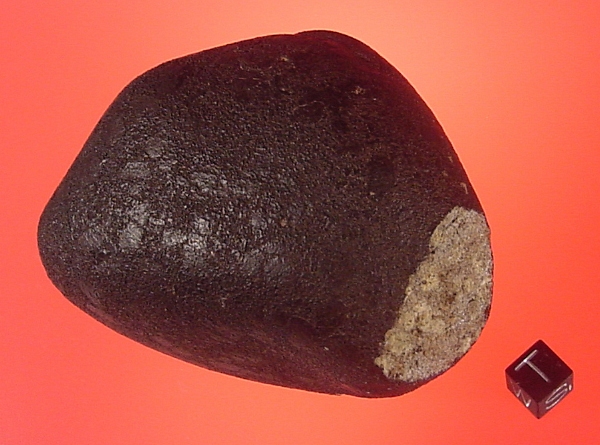
Whole shergottite
stone Northwest Africa 4468.
Large crystals of orthopyroxene are visible through the black fusion
crust.
Photo © G. Hupé
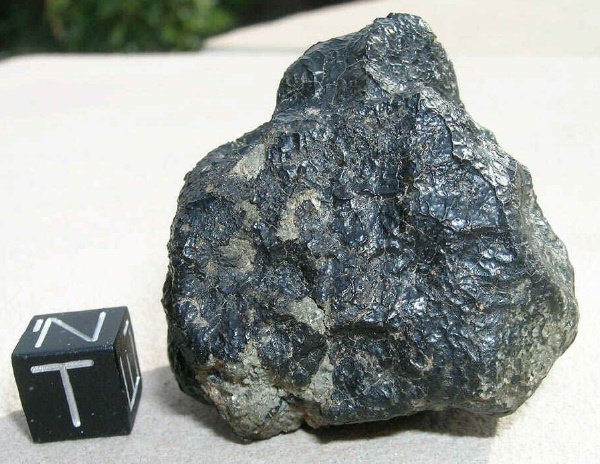
Whole Northwest
Africa 2975 stone, showing wrinkled fusion crust and gray interior
Photo © M. Farmer
|
|
|
|
Shergottite NWA 1950 |
Chassignite NWA 2737 |
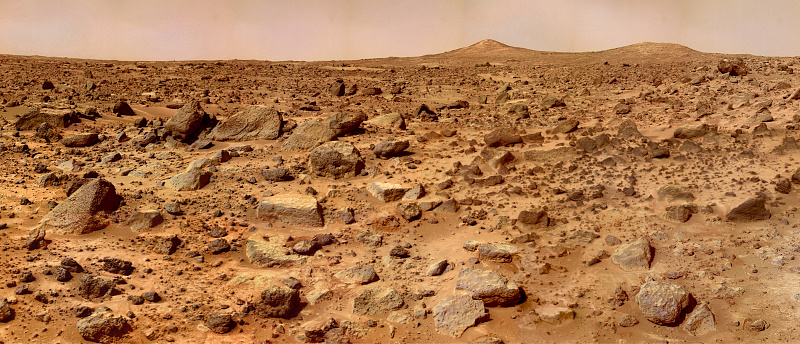
Mars Pathfinder landing site in Ares Vallis. Note the gray rocks covered by red-brown dust.
A lot of
metamorphosed terrestrial basaltic rocks (sometimes called greenstones)
contain green minerals (such as chlorite, actinolite, epidote and
serpentine), and these are the specimens most commonly mistaken by
amateur collectors as Martian meteorites. Without detailed testing, one
way to recognize a possible Martian meteorite is to look for obvious
fusion crust, which is a thin, black, glassy coating formed on the
exterior of all meteorites containing iron-bearing silicate minerals as
they plummet and decelerate through Earth's atmosphere. Unfortunately
most recently fallen stony meteorites of all types have black fusion
crusts, but if the
meteorite has resided on Earth for a long time any crust may have been
removed by weathering or wind-ablation.
Another test that is commonly done involves magnets; however, this has
proven to be a major problem for scientists interested in measuring the
magnetic properties of Mars. Martian meteorites are slightly magnetic,
but much less so than meteorites containing iron metal. A protocol has
been established for all Antarctic meteorites that NO magnets are ever
used near them. Unfortunately, nomads, dealers and private collectors
elsewhere frequently put very strong rare earth magnets on all
meteorites, which remagnetizes the outer portions of the specimens
instantly. If you want to test the magnetic properties of a possible
Martian or any other meteorite, please pry off a small crumb and test
that with a magnet instead of compromising the entire specimen. This
problem has necessitated core drilling or cutting of some meteorites for
magnetic studies in order to avoid the effects imposed by these
practices.
Shock during ejection of specimens from Mars (or even by impacts prior
to that) has produced some distinctive macroscopic features in many
Martian meteorites. The most prevalent varieties (shergottites) all
contain a diaplectic glassy form of plagioclase feldspar called
maskelynite. In fact, the type specimen for this mineral or
mineraloid (first described by Gustav Tschermak in 1872) is the
Shergotty meteorite! Maskelynite is readily recognizable by its
brilliant adamantine sparkle on broken surfaces examined in sunlight,
and it is isotropic (black) in cross-polarized light. Although
maskelynite is found also in some lunar and eucrite meteorites, it is
most diagnostic of Martian meteorites (except nakhlites and
"baby" shergottite NWA 4480, which
evidently experienced less shock). Even greater shock pressures and
temperatures have caused complete melting of plagioclase in some
shergottites (e.g., Allan Hills 77005, Dhofar 378, Northwest Africa
5298, Northwest Africa 6342), resulting in a distinctive "microspherulitic" texture of
quenched, anisotropic plagioclase blades or even the formation of
complex, vesicular feldspar-rich glass. Other common effects of shock are the
presence of small interior pockets of black glass (sometimes vesicular)
and/or cross-cutting thin veinlets of black glass. This evidently was injected in
a molten state into the rocks as they were spalled off Mars and contains
trapped Martian atmospheric gases.
Confirmation of the Martian origin of a meteorite requires microscopic
examination and special chemical analyses. The most common mineral
constituents are pyroxenes (pigeonite, augite and less commonly
orthopyroxene), olivine, plagioclase feldspar (usually now maskelynite),
oxides (titanomagnetite, ilmenite, chromite, baddeleyite), calcium
phosphates (merrillite, apatite), silica polymorphs (commonly exhibiting
post-shock changes) and iron sulfide (pyrrhotite). The chemical
compositions of all these minerals have specific known ranges, and in
particular the ratios of iron to manganese (Fe/Mn) in pyroxenes and
olivines are very characteristic, especially when considered in
combination with the plagioclase compositions (see plot above). Usually
a specimen can be recognized as Martian very readily once a transparent
thin section is made, or within a matter of minutes of examination of a
polished surface utilizing an electron microprobe. Of course, oxygen
isotope data would serve as further confirmation, but that is not
necessary (and the isotopic values for Martian meteorites are by
themselves non-unique).
Variation in mineral compositions
The major minerals (pyroxenes, olivine and plagioclase) in Martian meteorites show systematic compositional variations, depending on the bulk composition of each rock and the degree to which it underwent fractional crystallization during cooling and progressive solidification. Plagioclase compositions range from more sodic (i.e., lower in end-member component anorthite An) in nakhlites (An14-37, but mostly near An30) to typically much more calcic in shergottites (An33-74, but about half of that range in any given specimen). Pyroxenes in nakhlites are predominantly calcic (augite), whereas pyroxenes in shergottites are predominantly subcalcic (orthopyroxene and pigeonite), with augite present in most specimens as well. In a standard quadrilateral plot of the major end-member components (enstatite En, ferrosilite Fs, and wollastonite Wo), different specimens have differing patterns of compositional variation. One aspect of shergottites which is not evident from such plots is that wide variations in composition commonly occur within individual pyroxene grains. Such "chaotic" compositional zoning may reflect disequilibrium processes operative during solidification of shergottite magmas. Olivine in the more primitive shergottites typically also exhibits compositional zoning; however, there is evidence that some of this zoning has been differentially erased by diffusion in the more slowly cooled shergottites. Olivine in nakhlites and chassignites shows a narrower compositional range in keeping with the inferred formation of these rocks as igneous cumulates.
How are they classified? Why just one breccia specimen? What about sedimentary rocks?
Of the 207 known Martian meteorites, all but one are igneous rocks. Only one specimen (Northwest Africa 7034 and paired stones from Rabt Sbayta) is an impact-produced breccia (despite the fact that much of Mars is covered with impact craters). Among the igneous specimens, several ultramafic examples exhibit cataclastic structures and shock veining, but they are not fragmental breccias like those from the Moon or howardites. And so far no sedimentary rocks like those examined in the small area of the Meridiani Planum site have been recognized. The pie chart below sorts the 145 known igneous specimens on the basis of petrological categories based only on rock textures.
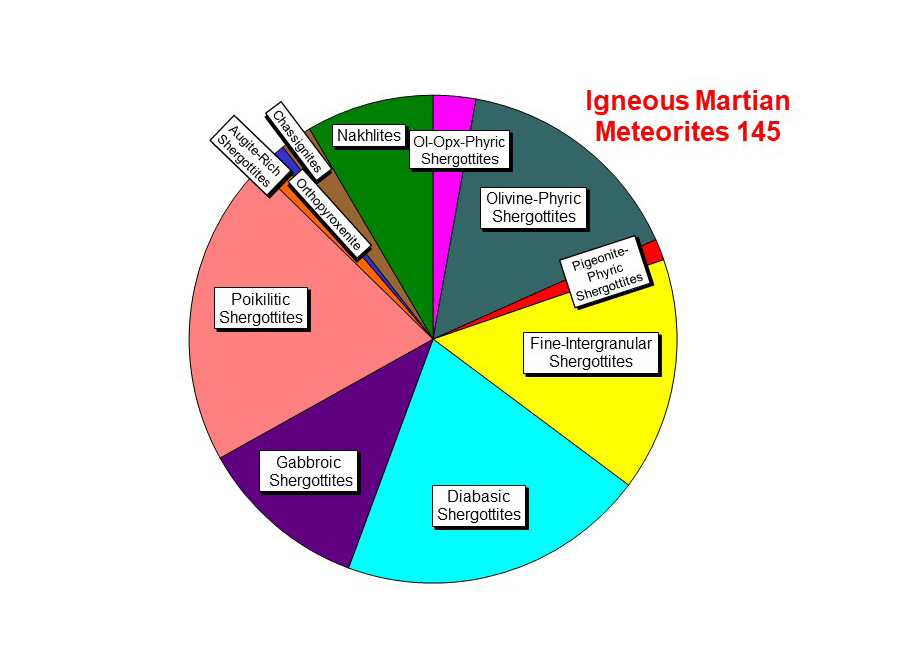
A
long-standing problem in studying natural things is what names to give
them. Nomenclature tends to be a human endeavor that changes over time,
as new understanding emerges. Ideally, scientific nomenclature should be
entirely descriptive with no hint of interpretation, but in practice
this is difficult to achieve. Scientists also have their own favorites,
and tend to want to retain some of the history of thinking on any
subject in the form of the names used. In the case of Martian
meteorites, three of the famous falls gave rise to the categories
shergottites, nakhlites and chassignites (the last of which had only one member
until the recovery of Northwest Africa 2737 in 2000 and Northwest Africa
8694 in 2014). Then in 1984 the Allan
Hills 84001 meteorite was found (and eventually recognized to be Martian
in 1994). This rock is composed mainly of orthopyroxene (with tiny
carbonate-rich regions), and it came to be called an
orthopyroxenite (which is a name applied to similar terrestrial
rocks). If we used terrestrial rock names, the shergottites might be
called pigeonite basalts (although they are not strictly basalts like
those on Earth), the nakhlites would be called olivine
clinopyroxenites, and the chassignites would be called dunites.
Things got more confusing with the unfortunate introduction (and
continued usage) of the name lherzolitic shergottite for a subset of
maskelynite-bearing Martian rocks (including the very first one found in
Antarctica). The problem is that the term lherzolite is applied to much
coarser grained terrestrial rocks rich in olivine and pyroxenes (i.e.,
ultramafic rocks called peridotites) that contain both
orthopyroxene and clinopyroxene as major
constituents. All but a few of the rocks that have been called lherzolitic shergottites definitely are
ultramafic (with very little maskelynite), but they are relatively fine
grained and contain no or up to 3 volume percent orthopyroxene. This
mistake may have been caused by confusion about the relevance of the low
Ca content in the major type of pyroxene (pigeonite), which approaches
the very low Ca contents in true orthopyroxene; nevertheless, pigeonite
is a clinopyroxene. The shergottites formerly dubbed
"lherzolitic" all have poikilitic textures (which means that they
contain some much larger grains that enclose lots of smaller grains of
other minerals), but several of these specimens (such as Northwest
Africa 1950, Northwest Africa 2646, Roberts Massif 04261/04262,
Northwest Africa 4468 and Northwest Africa 10169) also contain more than
10 volume% plagioclase, so they are not even ultramafic (like true
lherzolites). For these and other reasons Erin Walton, Anthony Irving,
Theodore Bunch and Christopher Herd recommended in 2012 that usage of
the term "lherzolitic" be discontinued for all shergottites in favor of
the textural term poikilitic. At least eight other
shergottites (Shergotty, QUE 94201, Los Angeles, NWA 480/1460, NWA 2800,
NWA 5029, JaH 479, NWA 5990) are sufficiently coarse grained to be
called diabasic shergottites, and at least two specimens (NWA 7032/7272
and NWA 7320) are even coarser grained gabbroic shergottites.
|
|
|
|
Optical thin section images in plane polarized light of
ultramafic shergottite NWA 4797 (left) and diabasic
shergottite NWA 1460 (right). Note the shock injection melt
vein cutting NWA 4797. |
|
|
Optical thin section images of olivine-orthopyroxene-phyric
shergottite NWA 1195 (left, cross-polarized light) and
diabasic shergottite NWA 5990 (right, plane polarized
light). Note that the plagioclase (maskelynite) in NWA 1195
is isotropic (black), and the shocked olivine in NWA 5990 is
distinctly brown. |
|
|
Optical thin section images of nakhlite Yamato 000593 (left,
plane polarized light) and chassignite NWA 2737 (right,
cross-polarized light). The major minerals in the nakhlite
are prismatic augite, equant olivine and magnetite (black),
and the plagioclase (white) in NWA 2737 is not
isotropic (i.e., less shocked than in most shergottites). |
|
|
|
|
|
False-color, back-scattered electron images of olivine
phenocrysts in NWA 1195 (left) and orthopyroxene |
|
Shergotty,
Zagami and similar olivine-free specimens commonly have been called
basaltic shergottites, but
a better term would be mafic shergottites (or perhaps
pigeonite-plagioclase shergottites). With the subsequent
discovery of olivine-bearing shergottites, such as Elephant Moraine
79001, Dar al Gani 476, Sayh al Uhaymir 005 and Northwest Africa 1068,
the term olivine-phyric shergottite has come into wide
usage. This term refers to the fact that the olivine grains are
relatively large and easily visible (like in porphyritic terrestrial
basaltic lavas); it is preferable to the term picritic, which was used
initially for Northwest Africa 1068. A variant of this term,
olivine-orthopyroxene-phyric shergottite, has been applied to
Northwest Africa 1195 and several other specimens in recognition that both
olivine and orthopyroxene are present as early-formed crystals (or
phenocrysts). The large crystals in Northwest Africa 1195 show a
preferred orientation of their longest dimensions, which probably is
indicative of magmatic flow within a subsurface conduit (and explains
the unusual elongated shape of the NWA 1195 stone).
These petrological names are for the most part descriptive, but they do
not convey the bulk chemical composition of these rocks and by inference
that of the magmatic liquid from which they crystallized. In the case of
terrestrial igneous rocks, it has long been known that batches of magma
underground can change their composition by progressive crystallization
of solid minerals in a particular sequence as temperatures fall. This
process is called fractional crystallization (and is
somewhat analogous to distillation), and it almost certainly affected
subsurface batches of magma on Mars as well. The adjectives more
primitive and more evolved are used on both
planets to designate, respectively, magmatic rocks that have undergone
less of this process (e.g., the olivine-orthopyroxene-phyric
shergottites) or more of it (resulting in loss of olivine and
orthopyroxene by crystal settling or plating out on reservoir walls).
Ironically, the first two shergottites known (Shergotty and Zagami) are
moderately evolved magmas, and there are others that are even more
evolved (Dhofar 378, Northwest Africa 5298, Los Angeles, Northwest
Africa 2800 and Ksar Ghilane 002). An
important corollary of this spread of bulk compositions is that if we
had only Shergotty (or even worse Los Angeles or NWA 2800) as samples from Mars, and
we thought that they represented magmatic liquids derived directly from
the Martian mantle, we would make serious errors in our estimates of the
composition of the Martian interior - we would conclude that it is much
more iron-rich than it evidently is.
|
|
|
|
Optical thin section image in cross-polarized light of Yamato 980459 (left) and macroscopic view of a fragment of Northwest Africa 5789 (right). Both specimens are primitive, permafic olivine-phyric shergottites, and almost identical in bulk chemical composition. |
|
The most
primitive shergottites discovered so far are Yamato 980459/980497 and
Northwest Africa 5789. Yamato 980459 is an unusual olivine-phyric
volcanic or shallow intrusive rock that does not contain any plagioclase
(or maskelynite) but it probably would have, if it had not
crystallized so rapidly to form its distinctive quenched groundmass.
Northwest Africa 5789 is another olivine-phyric shergottite containing
only a few volume percent plagioclase, so it actually is almost an
ultramafic rock (yet very different from Allan Hills 77005 and related
poikilitic rocks). These specimens contain very magnesian olivine (with
Mg/(Mg+Fe) of 0.85-0.86), implying that they crystallized from
mantle-derived magmas which rose so rapidly to the surface that
essentially no fractional crystallization took place. We can make a very
important inference from these specimens about the Martian mantle: it
must be composed mainly of olivine and low-Ca pyroxene and must have a
magnesium to iron ratio very similar to that of the Earth's mantle
(although the abundances of both magnesium and iron must be
higher in the Martian mantle).
Since the relatively small numbers of Martian meteorites are delivered
somewhat randomly to Earth, and their discovery and recognition is even
more variable, it should not be surprising that the first specimens
found (or even the most abundant ones) belonging to a particular
subgroup may not necessarily be representative of the range of rock
types in outcrops or subsurface formations on Mars.
A better classification scheme based on bulk chemical compositions
Since 1989 terrestrial volcanic (and even some shallow intrusive rocks) have been classified on the basis of their bulk chemical compositions rather than their mineralogical characteristics. This became necessary for several reasons: (1) numerous traditional names were confusing (in some cases different regional names were given to essentially the same type of rock), and (2) more rapidly cooled rocks commonly contain variable (but in some cases abundant) amounts of glass or very fine grained mesostasis, which is impossible or difficult to characterize mineralogically. On Earth, rocks such as basalt, andesite, phonolite, etc. have well-defined ranges of bulk chemical composition, even though they also have distinctive mineralogies. The same type of approach now may be necessary for the burgeoning collection of Martian igneous rocks that we have in the form of meteorites, and a proposed scheme is illustrated below. The boundaries separating the mafic, permafic and ultramafic categories are drawn somewhat arbitrarily, but fall within logical gaps in the current data array.
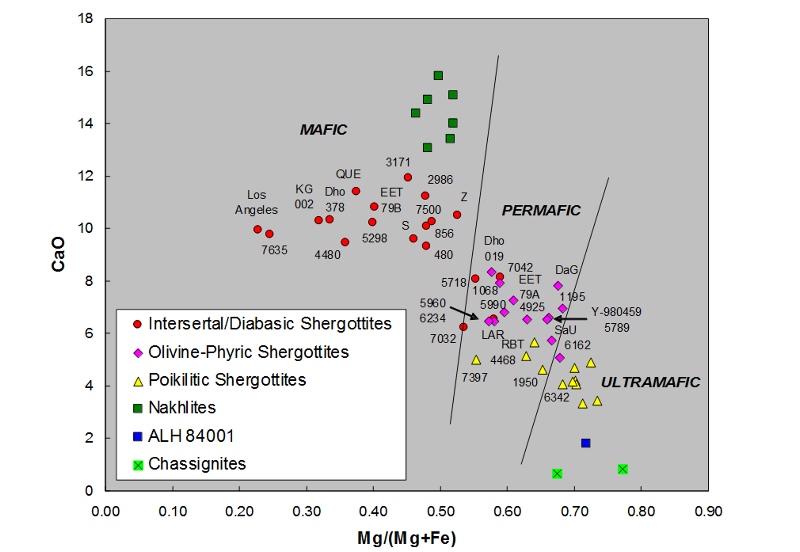
Within this framework of major element classes, it also is possible to designate textural type and the trace element/radiogenic isotopic characteristics that discriminate among the three different mantle source types (see below).
Classification Matrix for Shergottites (70)
[numbers with no prefix are NWA specimens (49)]
| Trace
element class →
Major element class ↓ |
ENRICHED | INTERMEDIATE | DEPLETED |
| MAFIC |
Shergotty,
Zagami, Los Angeles, Dho 378, JaH, 856, 1669, 2800, 2975, 3171, 5298, 5718, 6963/7258, Ksar Ghilane 002, 7257, 7320, 7500, 7944, 8653, 8656/57, 10134, 10171, 10281, 10414, 10558, Y-002192 |
EET 79B,
480/1460, 4480*, 5029 |
QUE 94, 7635, 8159 |
| PERMAFIC |
1068/1110,
GRV 02, 4468, RBT 04, LAR 06, 7397, 8637, 10169 |
EET 79A,
1950,
2646, 2990, 7042, 8705, 10567 |
DaG, SaU,
Dho 019, 1195, 2046, 2626, 4222, 4527/4925, Y-980459, 5789, 5990, 6162, 7032/7272, Tissint, LAR 12, 8686, "Jrifiya", 10416 |
| ULTRAMAFIC | [should exist] |
ALHA 77,
LEW 88, Y-793605, Y-984028, YA 1075, GRV 99, 4797, 6342 |
[should exist] |
|
Color-coded Textural Types: fine aphyric/intersertal, diabasic, gabbroic, pigeonite-phyric, olivine-phyric, poikilitic |
|||
| *See section on Trace Element Characteristics below | |||
Two olivine-phyric shergottites (NWA 6162 and Tissint) have been called permafic in the matrix chart above, even though at least one of these specimens plots in the ultramafic field. The reason is that these two specimens contain an apparent excess of large olivine crystals which evidently accumulated into the magmas before they ascended towards the surface of Mars. In fact, most of the olivine-phyric shergottites (except Yamato 980459, NWA 5789, and NWA 2990 and paired stones) contain differing amounts of excess olivine crystals, and thus their bulk compositions do not represent those of just the magmatic liquids (and they really should plot further to the left on the chart of Mg/(Mg+Fe) versus CaO). Scientists can decipher this anomaly because the compositions of the cores of the large olivine crystals in these shergottites are too magnesian to have been in equilibrium with the measured bulk compositions. The concept that early-formed olivine crystals might tend to accumulate into other batches of mafic magma in subsurface reservoirs is supported by well-documented examples of terrestrial basaltic lava flows containing such excess olivine crystals, notably the 1868 picritic basalt lava flow from Mauna Loa volcano in Hawaii.
Trace element characteristics of shergottites
A remarkable observation about the 118 known shergottites is that (with one exception) their trace element characteristics (at least for the 80 specimens analyzed so far) define three different major groups, termed depleted, intermediate and "enriched". The exception is unshocked shergottite Northwest Africa 4480, which has been shown to have characteristics between those for the intermediate and depleted groups. These same separate groupings are mirrored in their radiogenic isotopic compositions (see below). Within each of these major groups there is some variation, especially for those elements that are affected by fractional crystallization. However, for the group of 15 rare earth elements the abundances relative to those of chondrites are quite distinct in their patterns (see figure below). Because these patterns are controlled predominantly by the chemical composition and mineralogy of their mantle source regions, it can be concluded that there may be three major separate and different types of mantle domains within Mars from which shergottites were produced by partial melting (and which never convectively mixed with each other).
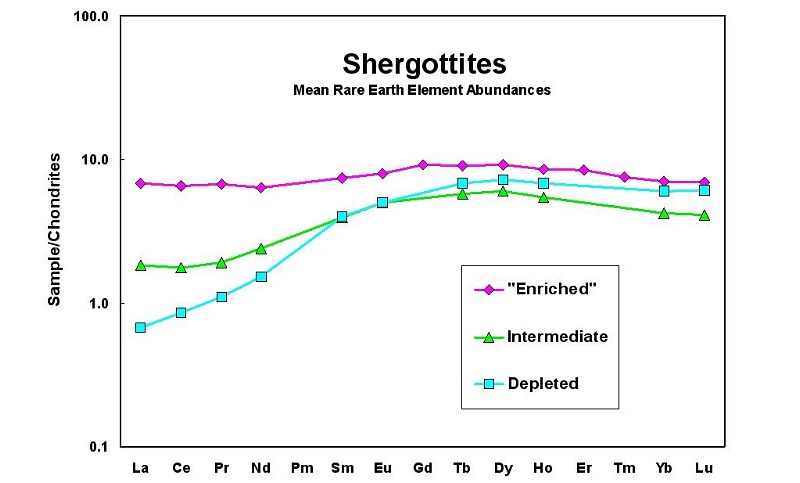
Why are Martian meteorites important? Where on Mars do they come from?
Despite
the stunning success of the six landed spacecraft on Mars, the only
actual Martian samples available for study on Earth are the Martian
meteorites. Scientists can conduct many more specialized analyses on
rock samples in terrestrial laboratories than it is possible to do with
remote robotic craft. For example, the exact mineralogy, mineral
chemistry and formation age of a rock on Mars cannot be determined
remotely. Still, the various rovers have provided invaluable in situ
morphological and chemical data about surface outcrops on Mars which are
not possible to obtain in other ways. Perhaps the most remarkable
finding is that the rocks at the landing sites are quite different from
the Martian meteorites. Based on studies by Jutta Zipfel and colleagues
of spectral data collected by the Opportunity rover, only one rock
("Bounce" at Meridiani Planum) might be compositionally similar to some
olivine-free shergottites. The rocks at the Pathfinder and Spirit
sites do appear to be fine grained to porphyritic lavas somewhat like
the shergottites, but they are different in detail. Many of them have
been pervasively modified from their original igneous state by
hydrothermal alteration or weathering processes, evidence of which we
see fairly clearly (but much less extensively) only in one group of Martian
meteorites, the nakhlites. Reasonable estimates of the ages of rocks at
the landing sites (based on impact crater densities determined from
orbit) are in the range 3-4 billion years, which is much older than the
ages determined for all but one of the Martian meteorites found so far.
Broad constraints on some aspects of the chemical compositions of
planetary surface materials can be obtained utilizing various types of
spectrometers on orbiting spacecraft. Unfortunately, such data have
limited spatial resolution (often no better than several hundred
kilometers), and can only see the upper few millimeters of
near-surface material. Mixing of materials by repeated impacts coupled
with secondary coatings by weathering products and wind-blown dust
significantly limit the relevance of these techniques in the case of
Mars. Even for the Moon, where hydrous alteration is absent, orbital
chemical maps do not give much specific information about the sources of
the at least 159 known lunar meteorites (see Randy Korotev's excellent
website). Harry McSween, Jeffrey Taylor
and Michael Wyatt have assessed data obtained from the Mars
Reconnaissance Orbiter and have made comparisons with robotic rock
analyses from the Pathfinder and MER landing sites and bulk compositions
of Martian meteorites (see
here). The clear differences among
these various measurements probably mean that the remote measurements
(and especially those from orbit) are compromised by secondary processes
that obscure the primary rock compositions. Nevertheless, one very
significant finding from analyses of the freshest rocks at Gusev crater
by the Spirit rover is that their bulk FeO/MnO ratios (44-48 for
Adirondack, Humphrey and Mazatzal) are very similar to those for
olivine-phyric shergottites (32-45), especially if differences in mafic
mineralogy are taken into account.
The Mössbauer spectrometer on the Spirit rover was able to determine
quite accurately the proportions of iron-bearing minerals in
mechanically-abraded igneous rocks such as Adirondack (see below), and
this spectrum can be compared with one collected in a terrestrial
laboratory on a thin wafer of Northwest Africa 1195. These two rocks
clearly contain similar major and minor minerals, but the proportions of
olivine and pyroxene are opposite: the meteorite (which is one of the
most primitive and most olivine-rich shergottites) actually has
less olivine than Adirondack. This must mean that the bulk
composition of Adirondack is quite different from that of any of the
shergottites. Viewed another way, this means that we might expect to
find other different types of Martian igneous rocks as meteorites (let
alone possible rare sedimentary rocks). Notice also that the Mössbauer
spectra confirm that both rocks contain ferric iron, but cannot tell us
anything about minerals such as feldspars or silica (which contain only
trace amounts of iron).
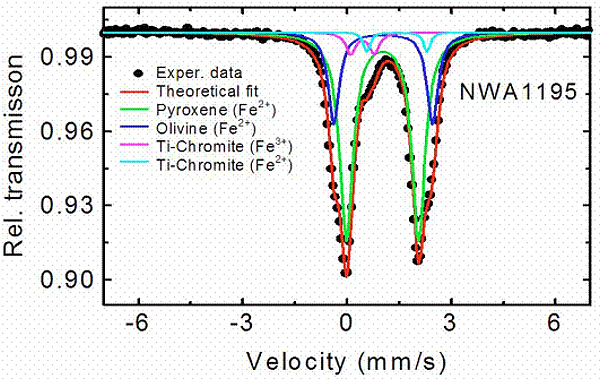
(Above) Thin wafer
transmission Mössbauer spectrum of shergottite
Northwest Africa 1195 (by Takele Seda)
(Below) Back-scattered spectrum of Adirondack measured by the Spirit
rover
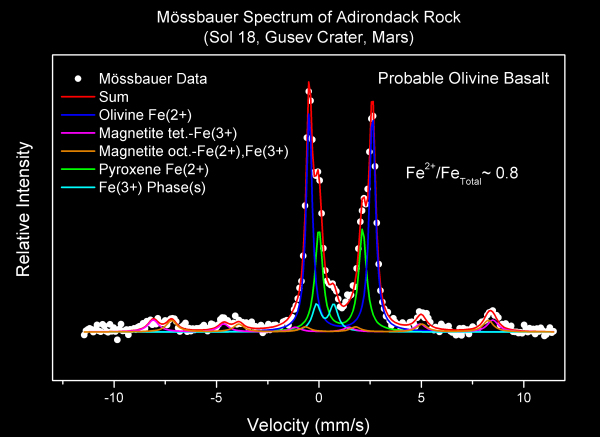
It is
difficult to be sure where on Mars the 207 Martian meteorites come from.
First, unlike the situation with lunar meteorites, they probably do not
come from 135 different sites, but instead more like 20 separate sites.
This is because more of the Martian meteorites probably are launch
paired; that is, they probably are pieces from different parts of single
lava flows or subsurface intrusions that are slightly different from
each other (due to natural heterogeneity in mineralogy and texture), but
which nevertheless are genetically related. We suspect this because of
clustering of cosmic ray exposure ages, which probably means that a
collection of disaggregated (but not necessarily originally adjacent)
fragments were ejected from certain target sites on Mars and traveled to
Earth together. A fascinating implication from this is that launch
paired pieces need not land in the same country (or even on the same
continent) on Earth.
Based on measurements of cosmogenic isotopes by Kunihiko Nishiizumi and
colleagues, one such group of specimens may include Dar al Gani 476,
Sayh al Uhaymir 005, NWA 1195, NWA 2046, NWA 2626, NWA 4222, NWA
4527/4925, Yamato 980459, NWA 5789, NWA 6162, Tissint, Larkman Nunatak
12095, NWA 7635 and NWA 8159 which
although differing from specimen to specimen in detailed mineralogy and
in formation age, could all be samples from the same depleted hypabyssal
igneous complex, but from different depths in a sequence of rocks that
experienced differing cooling rates of their parent magmas. An analogy
to consider would be a single impact into the pile of basaltic lava
flows of the Columbia Plateau of eastern Washington State, USA. The random ejecta
could include fragments ranging in age from 16 to 6 million years, with
varying igneous textures, different bulk compositions, and indeed a wide
range in trace element/isotopic characteristics.
The uncertainties about source craters do not stop people from
speculating about launch sites, however. The unique (so far) specimen
Allan Hills 84001 has such an ancient formation age that most scientists
consider that it came from somewhere in the ancient cratered terrain in
the southern hemisphere of Mars. One scientist has speculated based on
imperfect spectral arguments that the fifteen nakhlites and three chassignites (which
share many common characteristics) may come from the Syrtis Major
region, but overall none of the Martian meteorites is a good spectral
match for anywhere on Mars. More likely sources for shergottites are the
relatively young volcanic regions of Tharsis (especially Olympus Mons
see below) and Elysium Mons, but until we actually obtain samples from
those places this must remain conjectural. If we take a cue from the
lunar meteorites, then we should not be surprised that the Martian
meteorites have few (if any) counterparts at the Mars landing sites.
After all, if our only knowledge of the Moon was from lunar meteorites,
we would not know much at all about the high-titanium mare basalts that
are widespread at both the Apollo 11 and 17 sites.
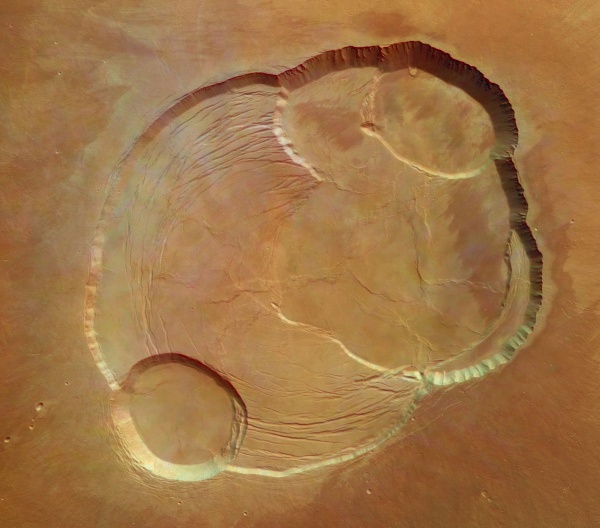
An exquisite image of
the 85 x 60 kilometer summit nested caldera of Olympus
Mons
taken by Mars Express. Note how few impact craters are present.
Let's go and land there (and bring a rock back)!
How old are they?
The apparent formation ages of the igneous rocks represented by Martian meteorites have generated considerable discussion. Some scientists would deem this a controversy, but it might be more properly called a dominant opinion countered by a minority view. The overwhelming body of evidence based on careful radiometric dating studies utilizing Rb-Sr, Sm-Nd, Lu-Hf and Ar-Ar systems applied to whole rocks and separated minerals, as well as the U-Pb system applied to baddeleyite, is that all of the shergottites have relatively young crystallization ages ranging from 150 to 2400 Ma ago. The nakhlites and chassignites have crystallization ages near 1.3 Ga, and Allan Hills 84001 has a Sm-Nd formation age >4 Ga and contains carbonates that were added at 3.9 Ga. [Note that the abbreviation for million years is Ma (Mega-annums) and for billion years is Ga (Giga-annums)]
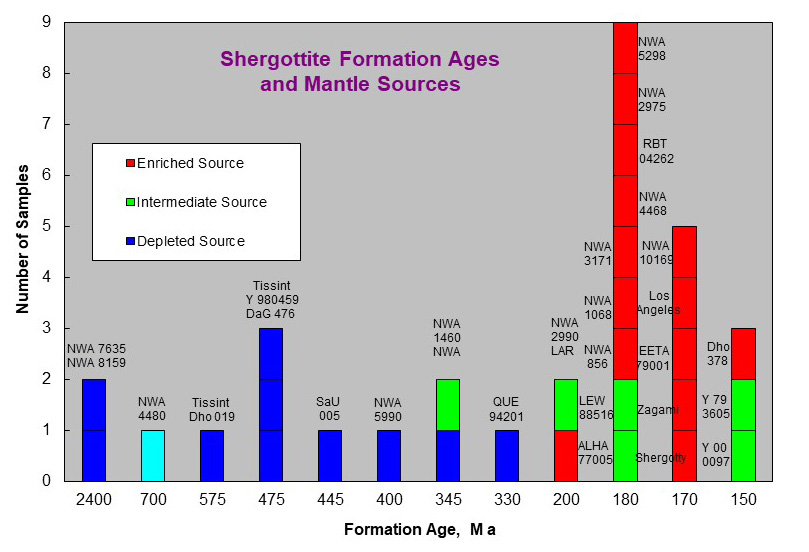
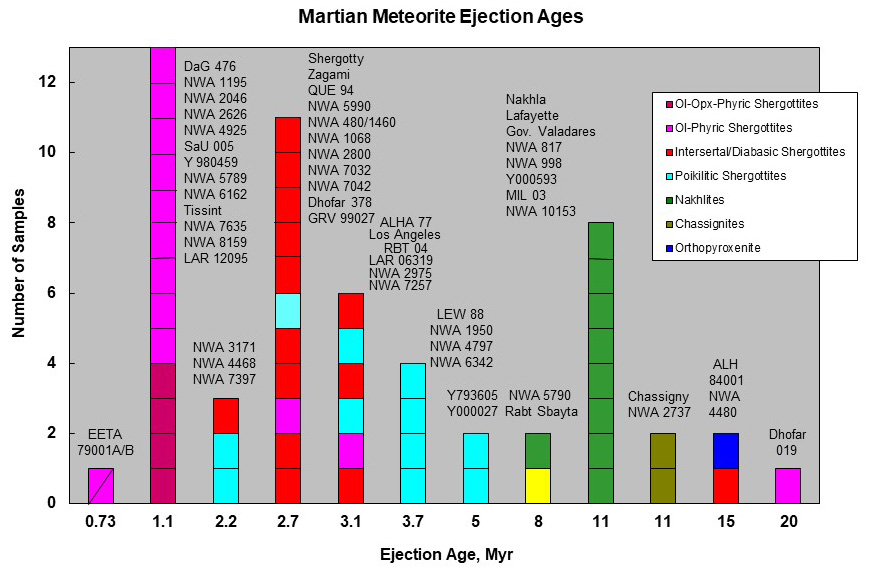
The minority view championed by one research group is that all the ages of shergottites were reset by shock events and/or hydrothermal alteration on Mars prior to meteorite ejection, and that their true crystallization ages are around 4.1-4.3 Ga. This conclusion is based on a particular interpretation of whole rock Pb-Pb isotopic data for shergottites. Most scientists reject this claim because there is no evidence of sufficient pre-ejection shock or hydrothermal alteration in the meteorite specimens, and because there are plausible alternative explanations for the Pb-Pb isotopic arrays as mixing lines involving terrestrial or (more likely) Martian crustal contaminants. The dominant view of the crystallization ages of dated shergottites is shown in a plot above, which also highlights the remarkable discovery that the different shergottites must be magmas formed by melting of just three distinct types of mantle geochemical reservoirs (depleted, intermediate and enriched).
The range of ejection ages for all Martian meteorites is shown in a second plot, and a third plot (below) shows both types of ages together. In addition, the terrestrial residence times for some Martian meteorites (as long as they are less than about 40,000 years) can be measured from the content of radioactive carbon-14 produced by cosmic ray interaction with oxygen atoms while the meteoroid was in space. For longer residence times, different cosmogenic isotopes are measured to obtain such estimates. These terrestrial ages range from essentially zero for falls (and Northwest Africa 1460) up to about 450,000 years (for Northwest Africa 4925).
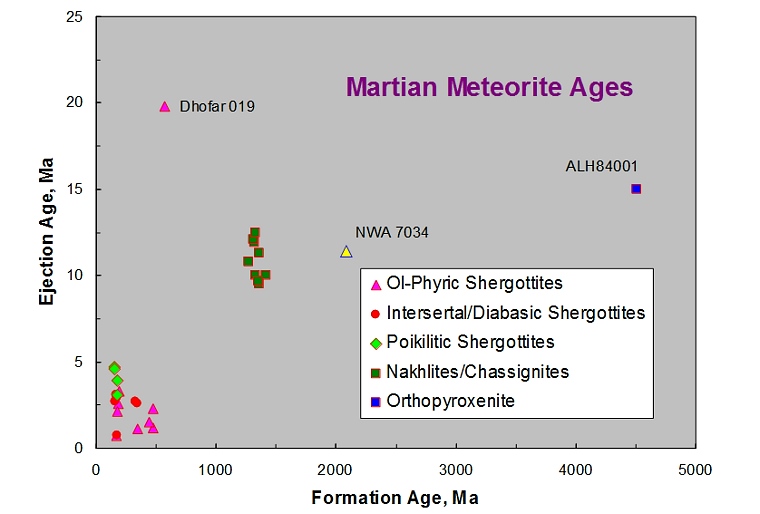
Martian mantle sources and implications for an ancient magma ocean
Mafic to ultramafic igneous rocks produced by partial melting of planetary mantles inherit isotopic characteristics from their deep source regions, and also can acquire secondary isotopic characteristics by reaction with mantle metasomatic fluids and/or by assimilation of crustal rocks during ascent. The neodymium and strontium isotopic parameters for shergottites and nakhlites exhibit a remarkable grouping into just four different and widely separated categories (see plot below). Are these groups a reflection of four different mantle source characteristics, or do they represent in part an overprint of subsequent isotopic components related to metasomatism and/or assimilation? A somewhat similar pattern observed for terrestrial basalts has been interpreted as signifying the variable operation of all these processes, but do similar processes occur also in Mars? For Earth, the metasomatic and assimilation processes almost certainly involve fluids rich in water, but for Mars it may very well be that similar processes (if they have operated at all) were mediated by fluids rich in halogens instead.
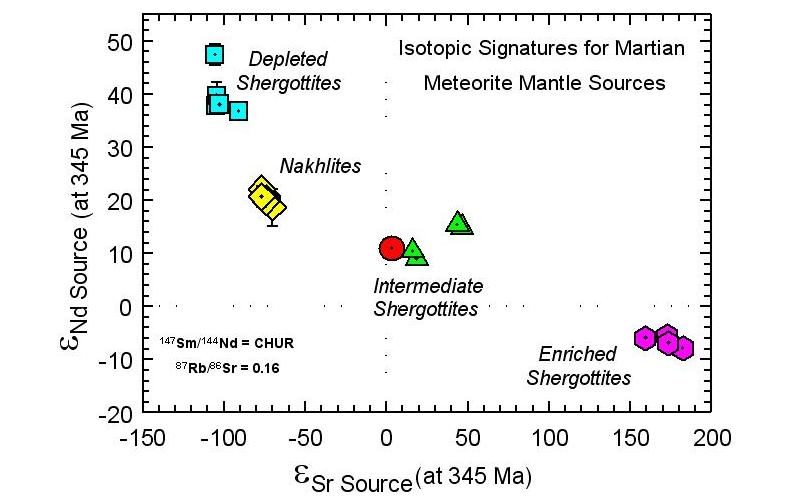
Studies of
terrestrial basaltic and mantle rocks have led to a consensus that the
Earth's mantle crystallized from an ancient magma ocean generated as a
consequence of formation of the metallic core. Although Mars is a much
smaller planet (possessing only 38% of the gravity of Earth), it too
apparently has a metal and/or iron sulfide-rich core, and it almost
certainly had an ancient magma ocean. Yet the smaller size of Mars and
consequent more rapid heat loss probably led to a much shorter duration
of convective mixing than for Earth so much shorter that different
chemical reservoirs may have remained isolated from each other for a
very long time, even until 1.3 billion years ago (when the nakhlite and
chassignite parent magmas were generated by partial melting).
One interesting chemical characteristic of Martian meteorites provides
strong support for this deduction. An isotope of tungsten (182-W) is a
product of radioactive decay of an isotope of hafnium (182-Hf), but the
half life is so short (8.9 million years) that all of the primordial
182-Hf has long since decayed away. The daughter isotope 182-W should
not be detectable in mantles that have undergone continued convective
mixing for several billion years. Yet, 182-W is present in shergottites
and nakhlites! The most logical explanation is that these relatively
young (1300-150 million year old) igneous rocks inherited their 182-W
from mantle reservoirs which had remained separate from other parts of
the Martian mantle since very early in the interior differentiation
history of the planet. In other words, the Martian magma ocean was
relatively short-lived in comparison with magma oceans in larger planets
like Earth and Venus.
Shock characteristics
All Martian meteorites have been shocked to varying extents. They experienced shock upon ejection from Mars, and some may have experienced shock from impacts onto the surface of Mars before that. For discussion of these topics, please consult Bevan French's wonderful treatise Traces of Catastrophe, Jeffrey Taylor's excellent article on shock and heating in asteroids, and articles by Erin Walton and Christopher Herd on specific analysis of shock features in shergottites. The peak shock pressures and temperatures can be estimated from mineralogical criteria calibrated by experimental studies, and range from about 25 GPa for nakhlites to 60-80 GPa and up to 2000°C for some shergottites (e.g., Allan Hills 77005, Northwest Africa 4797, Northwest Africa 6342). Of special importance in this field of inquiry are phases such as maskelynite, post-stishovite (after shocked silica), various types of melt glasses, injection veins, and even vapor bubbles and vugs. The black or dark brown color of olivine in some Martian meteorites (notably chassignite Northwest Africa 2737, shergottite Northwest Africa 1195 and shergottite Northwest Africa 5990) is now understood to be caused by shock-induced, solid-state precipitation of nanometer-sized particles of metallic iron.
Evidence for life?
The Allan Hills 84001 meteorite caused a sensation because of claims made in 1996 by David McKay and coworkers that it contained a preponderance of proposed evidentiary markers for life on Mars about 3.6 Ga ago. Over a decade later this evidence has nearly all been refuted, although not everything in this remarkable meteorite has been fully explained. For a discussion of these issues, see Allan Treiman's thorough summary. One intriguing aspect that has resisted full explanation is the morphology of tiny magnetite grains, which resemble those produced by magnetotactic bacteria on Earth; however, similarly shaped crystals do not necessarily imply a similar mechanism of origin. Lost in the rancor is the fact that the carbonates within Allan Hills 84001 almost certainly signify that liquid water was present on and within Mars 3.6 Ga ago, at a time when the first known microbial life was active on Earth (based upon the fossilized stromatolite mats of that age from Western Australia). It has been said by some that even if the Allan Hills 84001 meteorite does not really contain bona fide evidence for ancient life on Mars, it has served to promote public, political and research interest in Mars. While that may be so, it is troubling to many scientists that such interest was engendered for less than the right reasons. Still other scientists would say that the debate generated by the original claims was healthy, and showed the process of scientific inquiry in action. Perhaps the discussion about the true formation ages of shergottites mentioned above is another such issue, although one that understandably does not carry with it the special fervor associated with the search for evidence of past or current extraterrestrial biology.
A wish list of Martian meteorites!
1. More truly ancient samples similar to (or even different from) Allan
Hills 84001
2. More
impact-produced breccia specimens like Northwest Africa 7034
3. Sedimentary meteorites (preferably with hematite blueberries and
lots of jarosite)
4. Different types of igneous rocks (preferably like Adirondack or
Humphrey)
5. Highly altered, ancient rocks like those at the Spirit,
Opportunity and Curiosity landing sites
6. We'll take anything Martian! We now have 207 specimens!! With
the current pace of discovery I anticipated 100 specimens by 2020; this
has been reached 4 years sooner in November, 2016
Is 150 specimens the next plateau by 20??. Update: the 150 plateau
has now been reached in October, 2020. Is 200 specimens by 2024
the next plateau? Update: the 200 plateau has now been reached in
February 2024!! What is next; 250 by 2026?
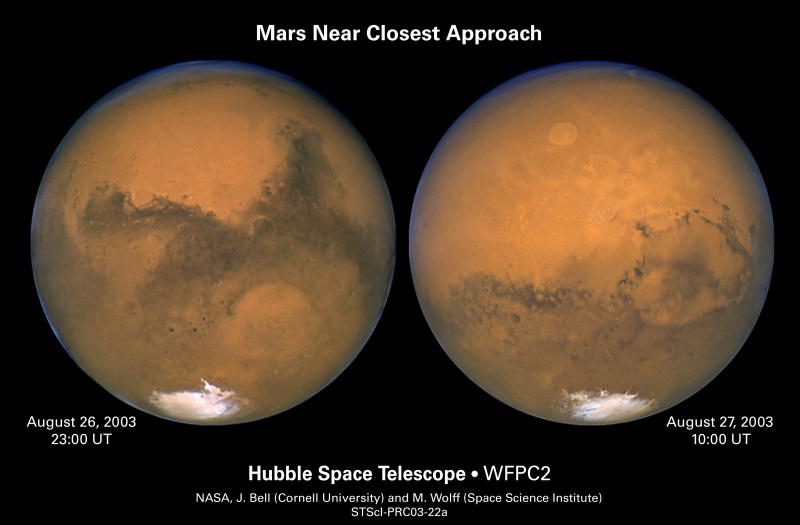
This site was created by and is managed by Dr. Tony Irving of the
University of Washington.
All
comments are welcome.
Hosting sponsored by the
International Meteorite Collectors Association, IMCA Inc.,
www.imca.cc
Last updated
4/7/2024
